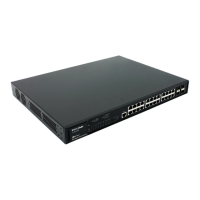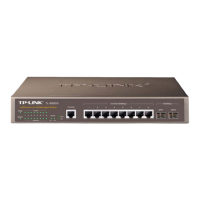JetStream 52-Port Gigabit Stackable L3 Managed Switch CLI Guide
35.14 snmp-server traps link-status
Description
The snmp-server traps link-status command is used to enable SNMP link
status trap for the specified port. To disable the sending of SNMP link status
trap, please use no snmp-server traps link-status command.
Syntax
snmp-server traps link-status
no snmp-server traps link-status
Command Mode
Interface Configuration Mode (interface fastEthernet / interface range
fastEthernet / interface gigabitEthernet / interface range gigabitEthernet/
interface ten-gigabitEthernet / interface range ten-gigabitEthernet)
Example
Enable SNMP link status trap for port 1/0/3:
T3700G-52TQ(config)# interface gigabitEthernet 1/0/3
T3700G-52TQ (config-if)# snmp-server traps link-status
35.15 rmon history
Description
The rmon history command is used to configure the history sample entry. To
return to the default configuration, please use no rmon history command.
RMON (Remote Monitoring), basing on SNMP architecture, functions to
monitor the network. History Group is one of the commonly used RMON
Groups. After a history group is configured, the switch collects network
statistics information periodically, based on which the management station
can monitor network effectively.
Syntax
rmon history
index
interface { fastEthernet
port
| gigabitEthernet
port
|
ten-gigabitEthernet
port
} [ interval
seconds
] [ owner
owner-name
]
[ buckets
buckets-number
]
no rmon history
index
Parameter
index
—— The index number of the entry, ranging from 1 to 12.
302

